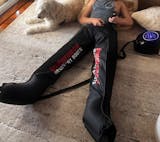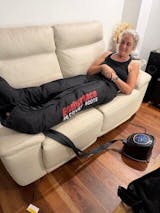Best Practices for Using Compression Boots

Introduction to Best Practices for Using Compression Boots
Compression boots are a revolutionary recovery gear that has been gaining popularity in recent years. These boots use pneumatic compression technology to improve recovery time after intense physical activity. The boots apply intermittent compression to the legs and feet, which helps to increase blood flow and reduce inflammation. Athletes, particularly endurance athletes, use compression boots to aid in recovery and improve performance.
There are several options available in the market. However, it is essential to choose the best one that suits your needs. Recoveryair compression boots are a popular choice among athletes due to their effectiveness in aiding recovery. They provide full body compression with active compression devices that make them more effective than other products like compression socks or garments.
For runners looking for the best compression boots, there are several factors to consider. Firstly, they need to look for boots that fit well and provide adequate pressure on their legs and feet. Secondly, they should consider the durability of the product as it is an investment in their health and fitness routine.
Recoveryair compression boots stand out from other recovery products due to their unique features such as adjustable pressure settings, customizable time settings, and easy-to-use interface. They also have a compact design that makes them easy to carry around while traveling for competitions or training sessions.
Using compression boots before a workout can help prepare your muscles for exercise by increasing blood flow and reducing muscle tension. This can lead to improved performance during workouts and faster recovery times afterward.
How Compression Boots Aid in Recovery
Increased blood flow and circulation are essential for muscle recovery after intense exercise or injury. Compression boots can help in this regard by promoting blood flow and aiding in the removal of metabolic waste while delivering oxygen and nutrients to muscles. This increased circulation helps reduce inflammation and swelling, which can speed up the recovery process.
Athletes, particularly runners, often use compression boots as part of their recovery plan because they help reduce muscle soreness and fatigue. By aiding in the removal of lactic acid build-up, athletes can train harder and more frequently, leading to better performance over time. Compression boots have been shown to be effective in reducing the risk of deep vein thrombosis (DVT) in patients who are immobile or have limited mobility.
Compression boots are also beneficial for those recovering from surgery or injury. They help prevent blood clots while improving overall recovery time by increasing blood flow to affected areas. When used as part of a comprehensive recovery plan that includes proper nutrition, hydration, and rest, compression boots can significantly improve outcomes.
One study conducted on 32 participants found that wearing compression boots for one hour post-exercise resulted in lower levels of lactate concentration compared to those who did not wear them. Another study showed that using compression therapy after knee surgery led to a significant reduction in pain and swelling compared to traditional methods.
Understanding the Benefits of Compression Boots for Recovery
Compression boots have become increasingly popular among athletes and fitness enthusiasts as a tool for workout recovery. They work by using air pressure to massage the legs, increasing blood flow and reducing inflammation. The benefits of using compression boots are numerous, ranging from faster muscle recovery to improved range of motion.
Faster Muscle Recovery
One of the most significant benefits of compression boots is their ability to speed up muscle recovery. By increasing blood flow and reducing inflammation, they help repair damaged muscles more quickly after a workout. This means that athletes can train harder and more frequently without risking injury or burnout.
Reduced Soreness
Another benefit of compression boots is their ability to reduce post-workout soreness. The massage-like effect of the boots helps flush out waste products like lactic acid, which can cause muscle pain and stiffness. This means that athletes can recover more quickly between workouts and get back to training sooner.
Improved Range of Motion
Compression boots can also improve range of motion by promoting flexibility in the muscles and joints. This makes it easier for athletes to perform exercises with proper form, reducing the risk of injury. Improved range of motion can lead to better athletic performance overall.
Prevent Injury
While many people use compression boots for post-workout recovery, they can also be used pre-workout as a warm-up tool. By increasing blood flow and promoting flexibility in the muscles, they can help prevent injury during exercise.
Enhanced Lymphatic Drainage
In addition to improving blood flow, compression boots also enhance lymphatic drainage. This means that they help remove waste products from the body more efficiently, further aiding in recovery after a workout.
Scientific Research
The benefits of compression boots have been supported by scientific research, making them a popular tool among professional athletes and trainers alike. For example, one study found that wearing compression garments after exercise reduced muscle soreness by up to 30%. Another study found that wearing compression boots before exercise improved muscle strength and power output.

Tips for Effective Use of Compression Boots
-
Selecting the Right Pressure Settings
Compression boots are a great tool to improve blood flow and reduce swelling in your legs. However, to ensure their effectiveness, it's important to select the appropriate pressure settings based on your needs and comfort level. Precise pressure is key when using compression boots, as too much pressure can cause discomfort or even injury, while too little pressure may not provide the desired benefits.
The first step in selecting the right pressure setting is to consult with your doctor or physical therapist. They can help you determine the appropriate level of compression for your specific condition and needs. Once you have an idea of what range of pressure will work best for you, start by trying out the lowest setting and gradually increasing it until you find a comfortable level.
It's important to note that different manufacturers may use different scales for measuring compression levels, so be sure to follow the instructions provided with your specific device. If at any point during use you experience discomfort or pain, immediately stop using the boots and consult with a medical professional.
-
Proper Positioning for Even Pressure Distribution
Another key factor in ensuring effective use of compression boots is proper positioning of your legs within them. This ensures even pressure distribution and maximum effectiveness throughout your entire leg.
When putting on the boots, make sure they are snug but not too tight around your calves. The foot portion should also fit comfortably without being constrictive. Once they're on, sit back or lie down with your feet elevated slightly above heart level to encourage blood flow.
If you're using compression boots as part of a post-workout recovery routine, it's important to wait until after cooling down before putting them on. This helps prevent further inflammation and promotes faster healing.
-
Monitoring Your Body's Response
Finally, it's crucial to monitor how your body responds to compression boot therapy over time. While they can be incredibly effective at reducing swelling and improving circulation when used properly, everyone's body is different and may require adjustments in usage or pressure levels.
If you notice any changes in symptoms or discomfort, consult with your doctor or physical therapist to determine the best course of action. They can help you adjust your usage as needed to ensure optimal results.
Best Practices for Using Compression Boots
Best Compression Boots for Optimal Recovery
Compression boots have become a popular tool among athletes and fitness enthusiasts. These boots provide static compression to the legs, promoting better blood flow and reducing muscle soreness. In this section, we'll discuss the best practices for using compression boots to maximize their benefits.
Choosing the Best Compression Boots
There are several brands of compression boots available in the market, but not all of them are created equal. It's important to choose reputable brands like Normatec and SLS3 that offer high-quality compression boots that are effective and durable. When selecting a pair of compression boots, consider factors such as size, comfort level, ease of use, and price point.
Using Compression Boots Effectively
To get the most out of your compression boots, it's essential to follow the manufacturer's instructions carefully. The recommended duration and frequency of use may vary depending on the brand and model you choose. Generally speaking, it's best to use compression boots after intense physical activity or as a recovery tool for athletes.
When using your compression boots, ensure that they fit snugly around your legs without being too tight or uncomfortable. You should also avoid wearing them for extended periods or while sleeping as this can hinder blood flow and cause discomfort.
Benefits of Compression Boots
Compression boots offer numerous benefits when used correctly. They help reduce muscle soreness by increasing blood circulation in the legs and aiding in lymphatic drainage. They can speed up recovery time by reducing inflammation and swelling in the legs.
Studies have shown that athletes who regularly use compression boots experience less muscle fatigue during workouts compared to those who don't use them. Moreover, they can improve range of motion in joints by promoting flexibility in muscles surrounding them.
The Importance of Proper Use and Incorporation of Compression Boots in Your Recovery Plan
The importance of proper use and incorporation of compression boots in your recovery plan cannot be overstated. These boots are an excellent tool for aiding in post-workout recovery, reducing muscle soreness, and improving circulation. However, to get the most out of them, it is crucial to follow best practices for using compression boots.
When using compression boots, it is essential to ensure that they fit correctly and are not too tight or too loose. Tight-fitting boots can cause discomfort and even restrict blood flow, while loose-fitting ones may not provide sufficient pressure to aid in recovery effectively.
Another best practice for using compression boots is to start with shorter sessions and gradually increase the time as your body adjusts. Overuse can lead to muscle fatigue and even injury. It is also important to stay hydrated during compression boot sessions as dehydration can exacerbate muscle soreness.
Using compression boots after a workout can be highly effective in reducing muscle soreness and promoting recovery. However, it is also important to incorporate other recovery techniques such as stretching, foam rolling, and proper nutrition into your routine for optimal results.
Incorporating compression boots into your overall fitness plan can be a game-changer for those looking to improve their performance and reduce the risk of injury. By following best practices for using compression boots, you can maximize their benefits and take your recovery game to the next level.




